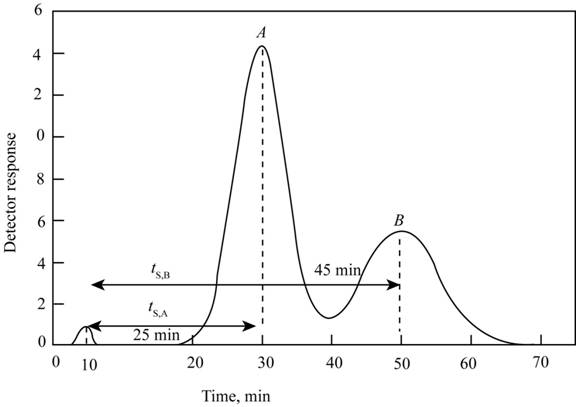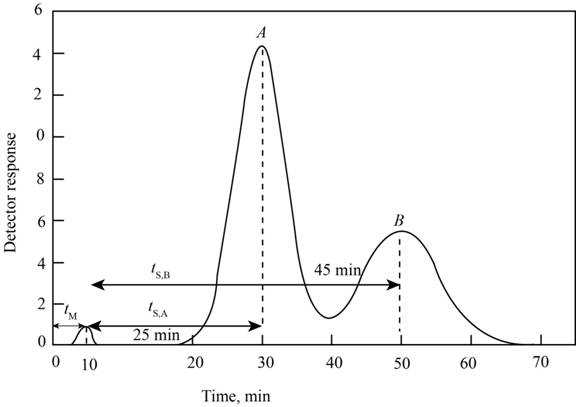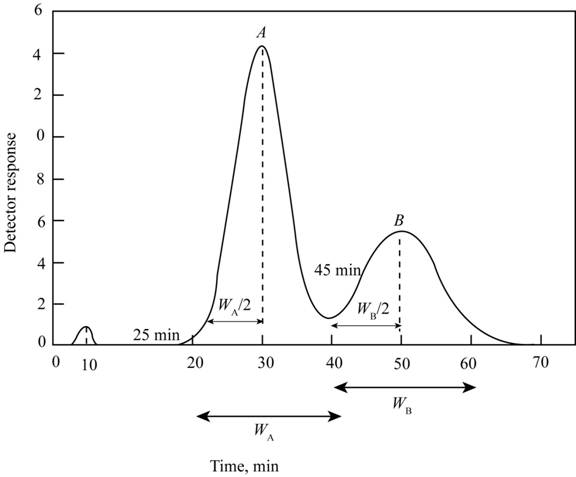
(a)
Interpretation:
The time spends by the component A and B in the stationary phase is to be stated.
Concept introduction:
The chromatography is the separation method for the substances of the mixture. The mobile phase consist the dissolved mixture in the fluid. This mixture is carried through the stationary phase of the material. Due the different speed of the particles the separation of the substance from the mixture takes place.
Answer to Problem 26.23QAP
The time spends by the component A and B in the stationary phase are
Explanation of Solution
Draw the diagram for the chromatogram of a two component mixture with the time period.

Figure-(1)
The Figure (1) shows that the time spend by the component A in the stationary phase is
Thus, the time spends by the component A and B in the stationary phase are
(b)
Interpretation:
The retention time for A and B are to be stated.
Concept introduction:
The chromatography is the separation method for the substances of the mixture. The mobile phase consist the dissolved mixture in the fluid. This mixture is carried through the stationary phase of the material. Due the different speed of the particles the separation of the substance from the mixture takes place.
Answer to Problem 26.23QAP
The retention time for the component A and B are
Explanation of Solution
Write the expression for the retention time of component A.
Here, the time spend by the component A in stationary phase is
Write the expression for the retention time of component B.
Here, the time spend by the component B in stationary phase is
Draw the diagram for the mixture of two components to show the time spent by the components in the stationary phase and the mobile phase.

Figure-(2)
The Figure (2) shows that the time spend by the component A in the stationary phase is
Substitute
Thus, the retention time of the component A is
Substitute
Thus, the retention time of the component B is
(c)
Interpretation:
The retention factors for the two components are to be stated.
Concept introduction:
The chromatography is the separation method for the substances of the mixture. The mobile phase consist the dissolved mixture in the fluid. This mixture is carried through the stationary phase of the material. Due the different speed of the particles the separation of the substance from the mixture takes place.
Answer to Problem 26.23QAP
The retention factors for the component A and B are
Explanation of Solution
Write the expression for the retention factor for the component A.
Write the expression for the retention factor for the component B.
Substitute
Thus, the retention factor for the component A is
Substitute
Thus, the retention factor for the component B is
(d)
Interpretation:
The full width of the each peak and full width at half maximum values are to be stated.
Concept introduction:
The chromatography is the separation method for the substances of the mixture. The mobile phase consist the dissolved mixture in the fluid. This mixture is carried through the stationary phase of the material. Due the different speed of the particles the separation of the substance from the mixture takes place.
Answer to Problem 26.23QAP
The full width for the component A and B are
The half width for the component A and B are
Explanation of Solution
Draw the diagram to show the full width and half width of both the components.

Figure-(3)
The Figure-(3) shows that the full width of the component A is
Thus, the full width for the component A and B are
Write the expression for the half width of the component A.
Write the expression for the half width of the component B.
Substitute
Thus, the half width for the component A is
Substitute
Thus, the half width for the component B is
(e)
Interpretation:
The resolution of two peaks is to be stated.
Concept introduction:
The chromatography is the separation method for the substances of the mixture. The mobile phase consist the dissolved mixture in the fluid. This mixture is carried through the stationary phase of the material. Due the different speed of the particles the separation of the substance from the mixture takes place.
Answer to Problem 26.23QAP
The resolution of two peaks is
Explanation of Solution
Write the expression for the resolution of two peaks.
Substitute
Thus, the resolution of two peaks is
(f)
Interpretation:
The average number of plates is to be stated.
Concept introduction:
The chromatography is the separation method for the substances of the mixture. The mobile phase consist the dissolved mixture in the fluid. This mixture is carried through the stationary phase of the material. Due the different speed of the particles the separation of the substance from the mixture takes place.
Answer to Problem 26.23QAP
The average number of plates is
Explanation of Solution
Write the expression for the number of the plate for the component A.
Write the expression for the number of the plate for the component B.
Write the expression for the average number of plates.
Substitute
Substitute
Substitute
Thus, the average number of plates is
(g)
Interpretation:
The average height of the plate is to be stated.
Concept introduction:
The chromatography is the separation method for the substances of the mixture. The mobile phase consist the dissolved mixture in the fluid. This mixture is carried through the stationary phase of the material. Due the different speed of the particles the separation of the substance from the mixture takes place.
Answer to Problem 26.23QAP
The average height of plate is
Explanation of Solution
Write the expression for the average height of the plate for the column.
Here, the length of the column is
Substitute
Thus, the average height of plate is
(h)
Interpretation:
The length of the column to achieve resolution of
Concept introduction:
The chromatography is the separation method for the substances of the mixture. The mobile phase consist the dissolved mixture in the fluid. This mixture is carried through the stationary phase of the material. Due the different speed of the particles the separation of the substance from the mixture takes place.
Answer to Problem 26.23QAP
The length of the column to achieve resolution of
Explanation of Solution
Write the expression for the average number of plate at
Here, the average number of plate at resolution 1 is
Write the expression for the column length to achieve resolution of
Substitute
Substitute
Thus, the length of the column to achieve resolution of
(i)
Interpretation:
The time required to achieve resolution of
Concept introduction:
The chromatography is the separation method for the substances of the mixture. The mobile phase consist the dissolved mixture in the fluid. This mixture is carried through the stationary phase of the material. Due the different speed of the particles the separation of the substance from the mixture takes place.
Answer to Problem 26.23QAP
The time required to achieve resolution of
Explanation of Solution
Write the expression for the time required at
Here, the time required to achieve the resolution 1 is
Substitute
Thus, the time required to achieve resolution of
(j)
Interpretation:
The measures required to increase the resolution to achieve the baseline separation are to be stated.
Concept introduction:
The chromatography is the separation method for the substances of the mixture. The mobile phase consist the dissolved mixture in the fluid. This mixture is carried through the stationary phase of the material. Due the different speed of the particles the separation of the substance from the mixture takes place.
Answer to Problem 26.23QAP
The resolution of the peak is increased by increasing the retention time of the species.
Explanation of Solution
Write the expression for the resolution of the peak.
Here, the retention time for the species A is
The Equation (XV) shows that the retention time is directly proportional to the resolution of the peak. Hence, the retention time have to increase to increase the resolution of the peak.
Thus, the resolution of the peak is increased by increasing the retention time of the species.
(k)
Interpretation:
The measures to achieve a better separation in a shorter time with the same column as in part j is to be stated.
Concept introduction:
The chromatography is the separation method for the substances of the mixture. The mobile phase consist the dissolved mixture in the fluid. This mixture is carried through the stationary phase of the material. Due the different speed of the particles the separation of the substance from the mixture takes place.
Answer to Problem 26.23QAP
The on increasing the resolution keeping the length of the column constant the better separation in a shorter time with the same column as in part j is achieved.
Explanation of Solution
Write the expression for the average number of the plates.
Here, the resolution of the peaks is
The Equation (XVI) shows that the average number of the plates is directly proportional to the square of the resolution. Hence, the average number of the plates increases on increasing the resolution keeping the length of the column constant. Due to this the better separation in a shorter time with the same column as in part j may be achieved.
Thus, the on increasing the resolution keeping the length of the column constant the better separation in a shorter time with the same column as in part j is achieved.
Want to see more full solutions like this?
Chapter 26 Solutions
INSTRUMENTAL ANALYSIS-ACCESS >CUSTOM<
- Using the bond energy values, calculate the energy that must be supplied or is released upon the polymerization of 755 monomers. If energy must be supplied, provide a positive number; if energy is released, provide a negative number. Hint: Avogadro’s number is 6.02 × 1023.arrow_forward-AG|F=2E|V 3. Before proceeding with this problem you may want to glance at p. 466 of your textbook where various oxo-phosphorus derivatives and their oxidation states are summarized. Shown below are Latimer diagrams for phosphorus at pH values at 0 and 14: Acidic solution -0.93 +0.38 -0.51 -0.06 H3PO4 →H4P206 H3PO3 H3PO2 → P→ PH3 -0.28 -0.50 → -0.50 Basic solution 3-1.12 -1.57 -2.05 -0.89 PO HPO →→H2PO2 P PH3 -1.73 a) Under acidic conditions, H3PO4 can be reduced into H3PO3 directly (-0.28V), or via the formation and reduction of H4P2O6 (-0.93/+0.38V). Calculate the values of AG's for both processes; comment. (3 points) 0.5 PH, 0.0 -0.5- 2 3 9 3 -1.5 -2.0 Pa H,PO H,PO H,PO -3 -1 0 2 4 Oxidation state, N 2 b) Frost diagram for phosphorus under acidic conditions is shown. Identify possible disproportionation and comproportionation processes; write out chemical equations describing them. (2 points) c) Elemental phosphorus tends to disproportionate under basic conditions. Use data in…arrow_forwardThese two reactions appear to start with the same starting materials but result in different products. How do the chemicals know which product to form? Are both products formed, or is there some information missing that will direct them a particular way?arrow_forward
- What would be the best choices for the missing reagents 1 and 3 in this synthesis? 1. PPh3 3 1 2 2. n-BuLi • Draw the missing reagents in the drawing area below. You can draw them in any arrangement you like. • Do not draw the missing reagent 2. If you draw 1 correctly, we'll know what it is. • Note: if one of your reagents needs to contain a halogen, use bromine. Explanation Check Click and drag to start drawing a structure. 2025 McGraw Hill LLC. All Rights Reserved. Terms of Use | Priva ×arrow_forwardPredict the products of this organic reaction: Explanation Check IN NaBH3CN H+ ? Click and drag to start drawing a structure. D 5 C +arrow_forwardPredict the products of this organic reaction: H3O+ + ? • Draw all the reasonable products in the drawing area below. If there are no products, because no reaction will occur, check the box under the drawing area. • Include both major and minor products, if some of the products will be more common than others. • Be sure to use wedge and dash bonds if you need to distinguish between enantiomers. No reaction. Click and drag to start drawing a structure. dmarrow_forward
- Iarrow_forwardDraw the anti-Markovnikov product of the hydration of this alkene. this problem. Note for advanced students: draw only one product, and don't worry about showing any stereochemistry. Drawing dash and wedge bonds has been disabled for esc esc ☐ Explanation Check F1 1 2 F2 # 3 F3 + $ 14 × 1. BH THE BH3 2. H O NaOH '2 2' Click and drag to start drawing a structure. F4 Q W E R A S D % 905 LL F5 F6 F7 © 2025 McGraw Hill LLC. All Rights Reserved. Terms of Use | Privacy Center | Accessibility < & 6 7 27 8 T Y U G H I F8 F9 F10 F11 F12 9 0 J K L P + // command option Z X C V B N M H H rol option commandarrow_forwardAG/F-2° V 3. Before proceeding with this problem you may want to glance at p. 466 of your textbook where various oxo-phosphorus derivatives and their oxidation states are summarized. Shown below are Latimer diagrams for phosphorus at pH values at 0 and 14: -0.93 +0.38 -0.50 -0.51 -0.06 H3PO4 →H4P206 →H3PO3 →→H3PO₂ → P → PH3 Acidic solution Basic solution -0.28 -0.50 3--1.12 -1.57 -2.05 -0.89 PO HPO H₂PO₂ →P → PH3 -1.73 a) Under acidic conditions, H3PO4 can be reduced into H3PO3 directly (-0.28V), or via the formation and reduction of H4P206 (-0.93/+0.38V). Calculate the values of AG's for both processes; comment. (3 points) 0.5 PH P 0.0 -0.5 -1.0- -1.5- -2.0 H.PO, -2.3+ -3 -2 -1 1 2 3 2 H,PO, b) Frost diagram for phosphorus under acidic conditions is shown. Identify possible disproportionation and comproportionation processes; write out chemical equations describing them. (2 points) H,PO 4 S Oxidation stale, Narrow_forward
- 4. For the following complexes, draw the structures and give a d-electron count of the metal: a) Tris(acetylacetonato)iron(III) b) Hexabromoplatinate(2-) c) Potassium diamminetetrabromocobaltate(III) (6 points)arrow_forward2. Calculate the overall formation constant for [Fe(CN)6]³, given that the overall formation constant for [Fe(CN)6] 4 is ~1032, and that: Fe3+ (aq) + e = Fe²+ (aq) E° = +0.77 V [Fe(CN)6]³ (aq) + e¯ = [Fe(CN)6] (aq) E° = +0.36 V (4 points)arrow_forward5. Consider the compounds shown below as ligands in coordination chemistry and identify their denticity; comment on their ability to form chelate complexes. (6 points) N N A B N N N IN N Carrow_forward
 Principles of Instrumental AnalysisChemistryISBN:9781305577213Author:Douglas A. Skoog, F. James Holler, Stanley R. CrouchPublisher:Cengage Learning
Principles of Instrumental AnalysisChemistryISBN:9781305577213Author:Douglas A. Skoog, F. James Holler, Stanley R. CrouchPublisher:Cengage Learning


